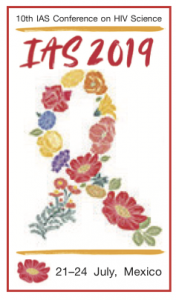10th IAS Conference on HIV Science (IAS 2019) in Mexico City
24 July 2019. Related: Conference reports, Conference index, IAS 10 Mexico City 2019.
 Simon Collins, HIV i-Base
Simon Collins, HIV i-Base
The 10th IAS Conference on HIV Science (IAS 2019) in Mexico City was held from 21 – 24 July 2019.
The meeting included more than 5,000 participants from more than 140 countries.
This year the meeting had a particulaly exciting programme,:
- A strong focus on new antiretroviral drugs, including for PrEP.
- ART strategies with new and existing drugs.
- An important (and optimistic) update on neural tube defects with dolutegravir, with a comprehensive review of the latest data.
- Updates to WHO treatment guidelines
The programme is already posted online, with abstracts and PowerPoint slides available for many of the presentations.
Webcasts from oral presentations, including the opening sessions are posted to the conference YouTube channel.
https://www.youtube.com/channel/UC43XbxjX7RZZ_gK9Vt8Z8FA/videos
Early HTB reports will be posted below as soon as they are available.
These include:
- Dolutegravir neural tube defect risk declines but still slightly higher than with other antiretrovirals
- WHO recommends dolutegravir-based ART regimens for all
- High rates of viral suppression with low dose efavirenz in pregnant Zambian women
- Dolutegravir/lamivudine dual therapy non-inferior to triple ART at week-96
- Switching to dolutegravir/lamivudine dual therapy is non-inferior to TAF-based triple therapy at week-48 in TANGO study
- Dual therapy with islatravir (MK-8591) plus doravirine: 24 week results as switch strategy
- First viral load results for capsid inhibitor GS-6207: mean –2.2 log reduction at day 10
- Islatravir (MK-8591) in new fixed dose combination (FDC) with doravirine plus lamivudine: 24 week results
- Fostemsavir: 96-week follow-up in people with multi-drug resistance
- Islatravir (MK-8591) implant sustains HIV PrEP protection for more than one year
- IAS 2019: late breaker highlights

